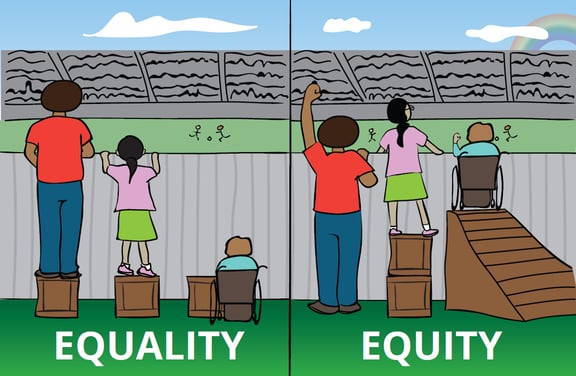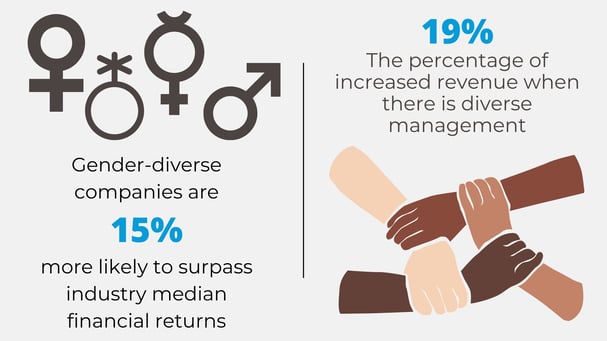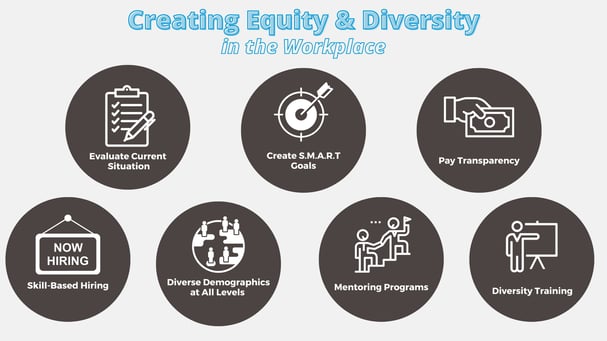Creating Diversity and Equity in the Workplace
Equity is the quality of being fair or impartial. This is not to be confused with equality. Equality is an equal opportunity and equal support for all employees while equity is providing varying levels of support depending on the need to achieve greater fairness of outcomes.
Diversity is the practice of involving people from different social and ethnic backgrounds and of different genders, sexual orientations, and other groups.
How do these affect your company? For starters, diverse and equitable companies could see more job applicants. According to a CNBC/SurveyMonkey poll, 80% of respondents said they wanted to work for a company that values diversity, equity, and inclusion. Furthermore, gender-diverse companies are 15% more likely to surpass industry median financial returns while companies see a 19% increase in revenue when their management is diverse.

Additional benefits include more creative solutions and a better problem-solving team. Improved decision-making because of diverse backgrounds, happier employees which reduce the rate of turnover, and a healthier brand image for your company.
How can you begin the process of providing a diverse and equitable workplace? You’ll first want to evaluate where your company stands right now. You don’t know what you need to improve unless you know where you’re starting. You can do this by surveying employees anonymously and creating a diversity, equity, and inclusion (DEI) committee to oversee the evaluation and implementation processes.
Using what you’ve learned during the evaluation phase, you’ll create a set of measurable and achievable goals. Creating S.M.A.R.T goals – Specific. Measurable. Attainable. Relevant. Time-bound – is the best way to show your employees and the public that equity and diversity are important to you and that you have a clear path to make it happen.
Next, create pay transparency in job applications. Make it acceptable to speak about salaries and wages openly. Remember that women of all races earn on average 0.82 cents for every 1 dollar a man of their race earns. And African American women make 0.62 percent for every 1 dollar an African American man makes. Close that gap with pay transparency.
In the hiring and promotion processes, it’s important to also focus on skill-based hiring versus educational opportunities. Understanding that everyone doesn’t have the same advantages when it comes to college opportunities can help you create a more equitable workplace. Skill-based hiring allows a wider range of people to be considered for a job opening or promotion.
Furthermore, work on creating a diverse demographic for every level of business. From the front-line workers all the way up to top management and in every department, make sure that there is diversity within each section. This creates a more well-rounded work environment and can stimulate creativity and problem-solving.
Creating DEI programs within your organization is also important. Require regular diversity training for all employees and more specific equity training for managers and hiring personnel. Also, create a mentorship program that meets regularly during work hours. Pair employees with similar goals and areas of focus but with different backgrounds.

If this all seems fairly straightforward, it is. Then why do DEI initiatives often fail?
Employees get tired when DEI’s aren’t implemented properly and aren’t well defined. They get weary of useless efforts and initial support can turn to backlash. This is often because they believe the company isn’t actually committed to DEI. This can lead them to undermine or hold back from initiatives. Then there is denial. Whether they truly don’t believe equity is an issue or not, employees can simply say they deny there is any sort of issue and decide they don’t want the “hassle” of addressing it.
To avoid failed DEI initiatives make it clear to employees with sold, achievable goals that diversity and equity are important to you. Follow through on those goals and regularly re-assess your company’s situation. All of the steps and recommendations above will help you take strong action and achieve better diversity and equity within your organization.



